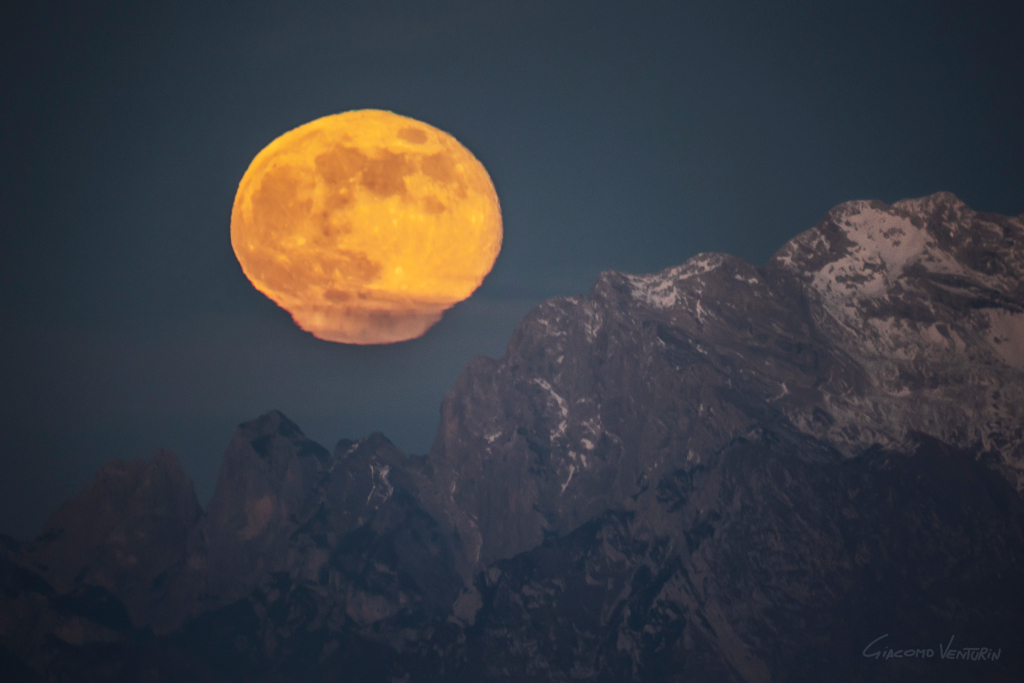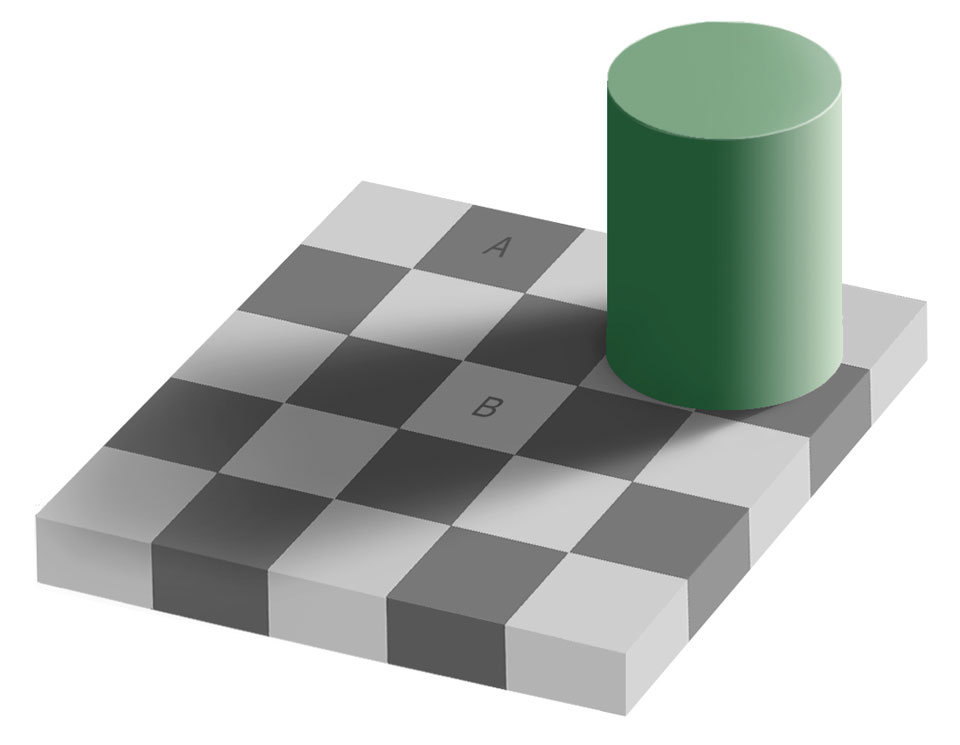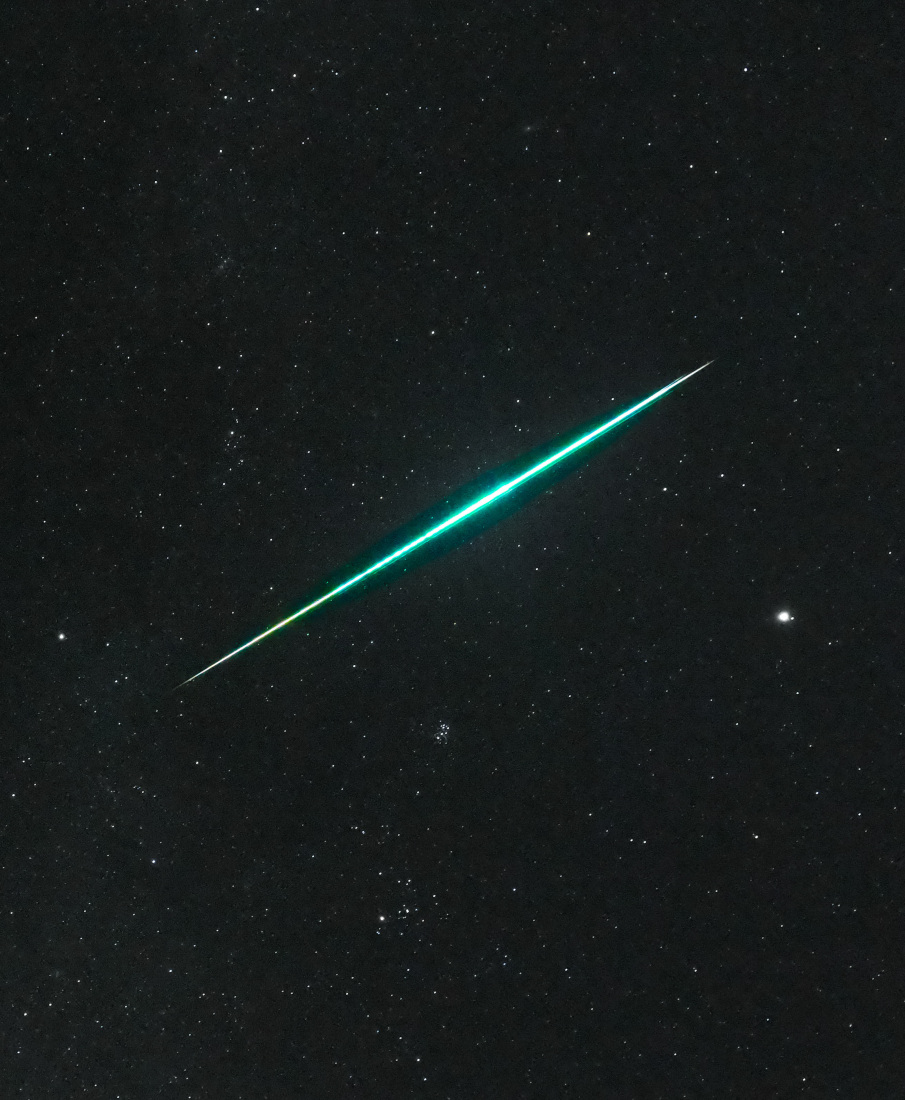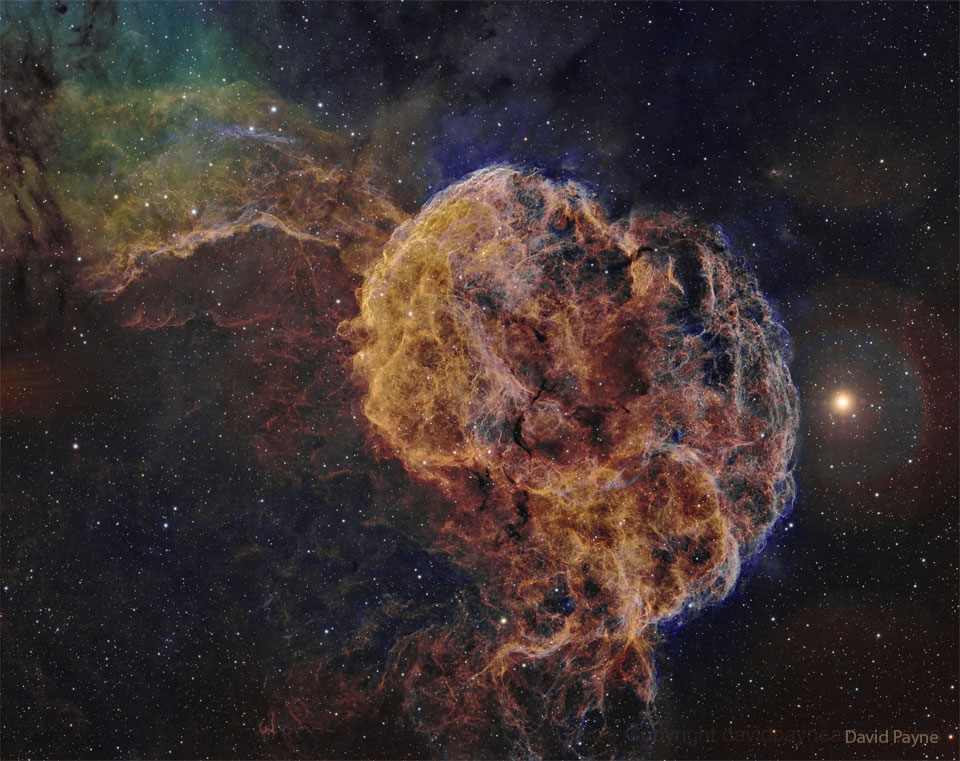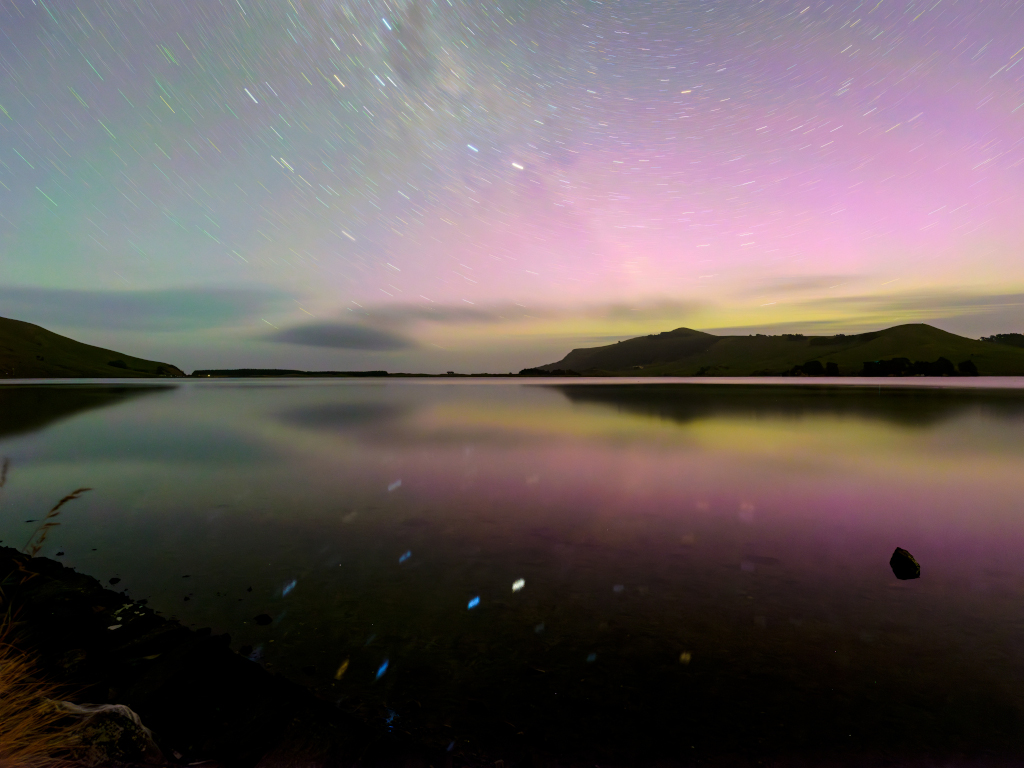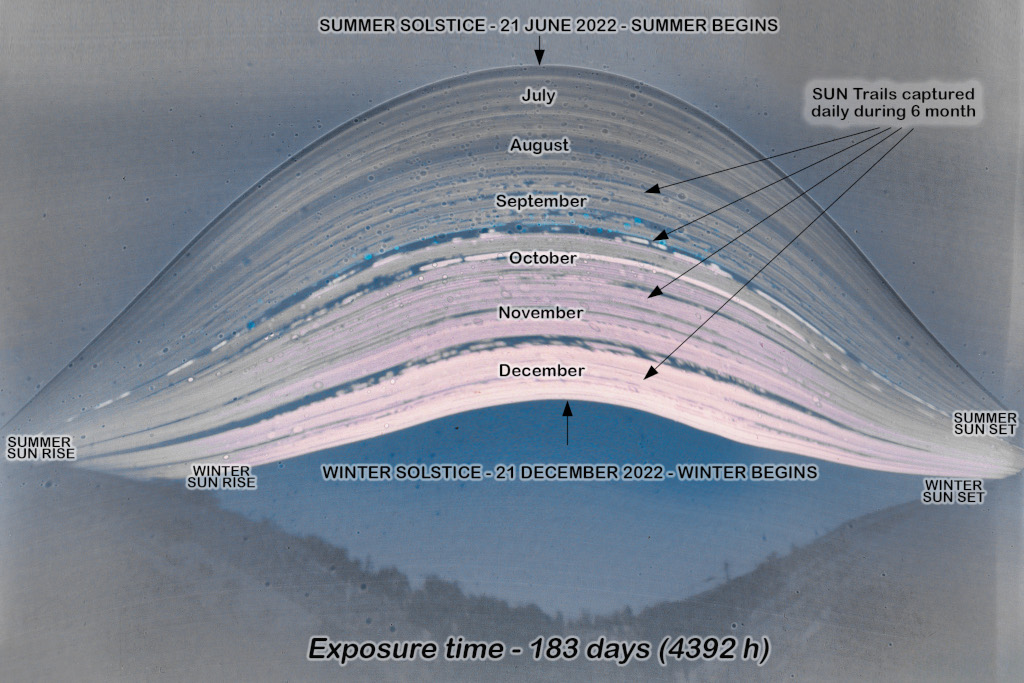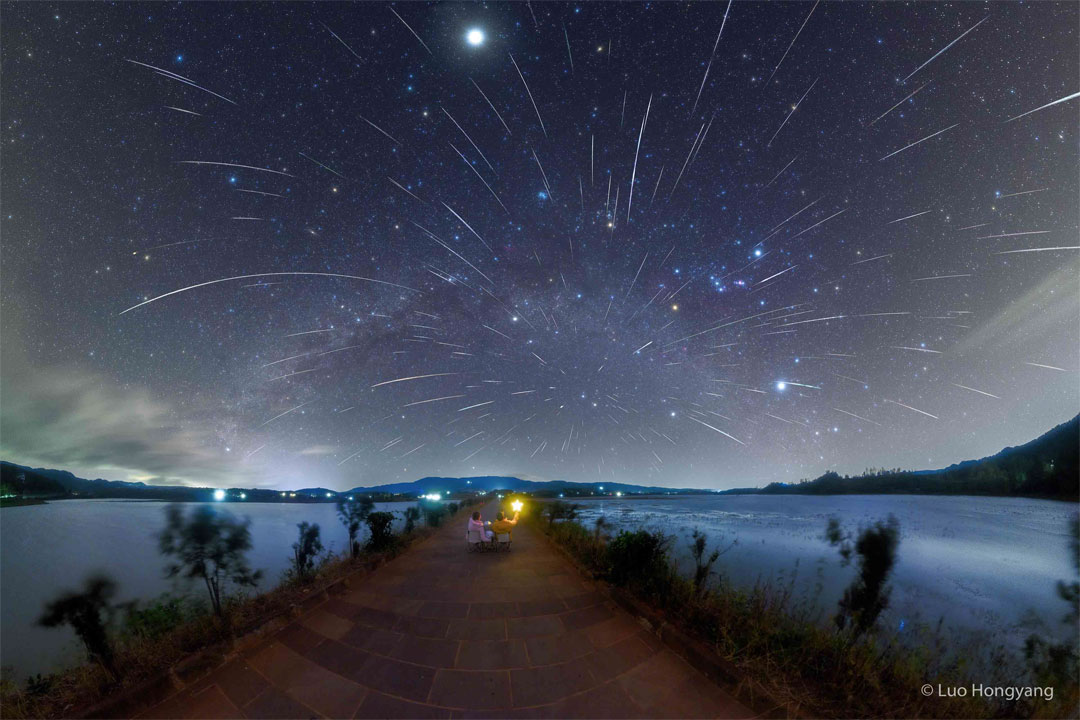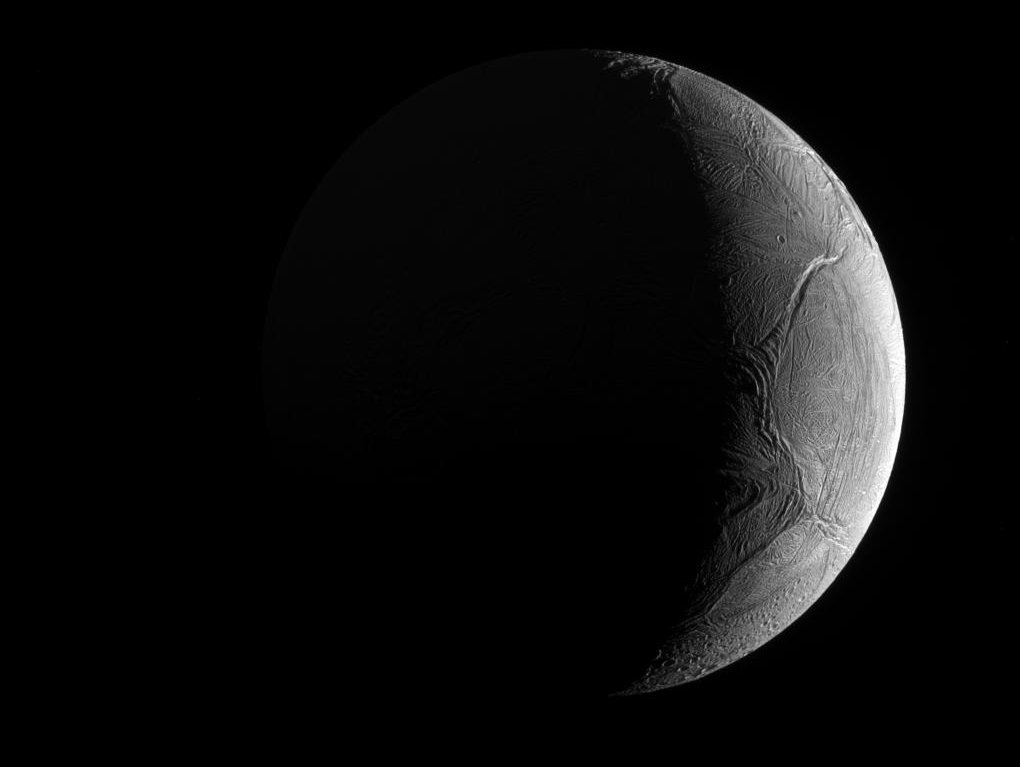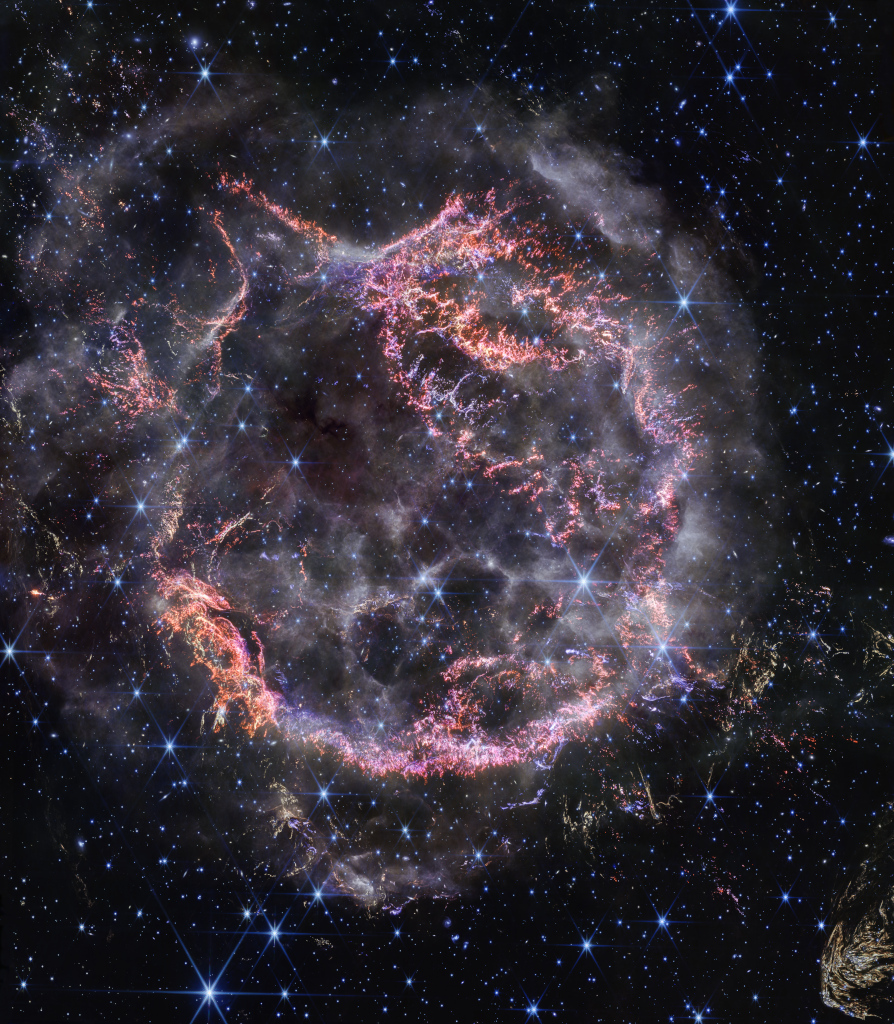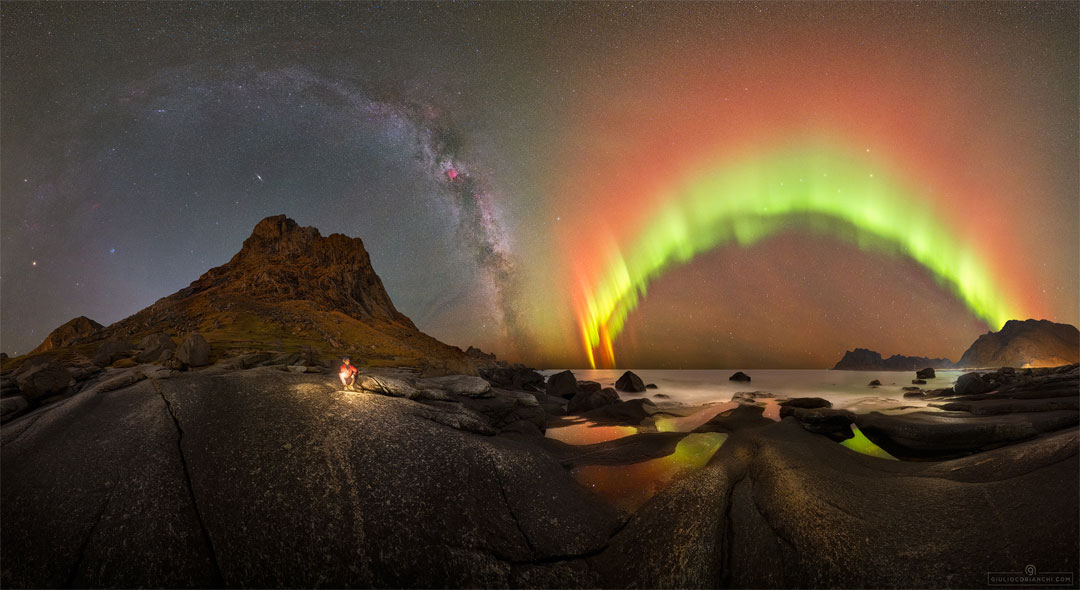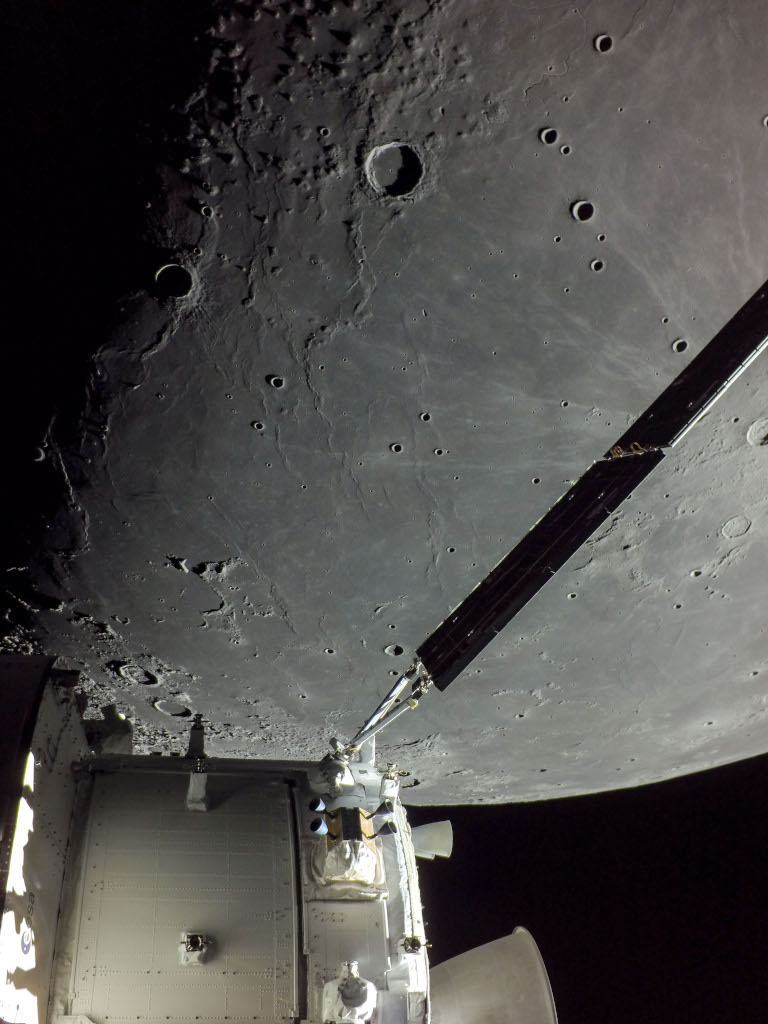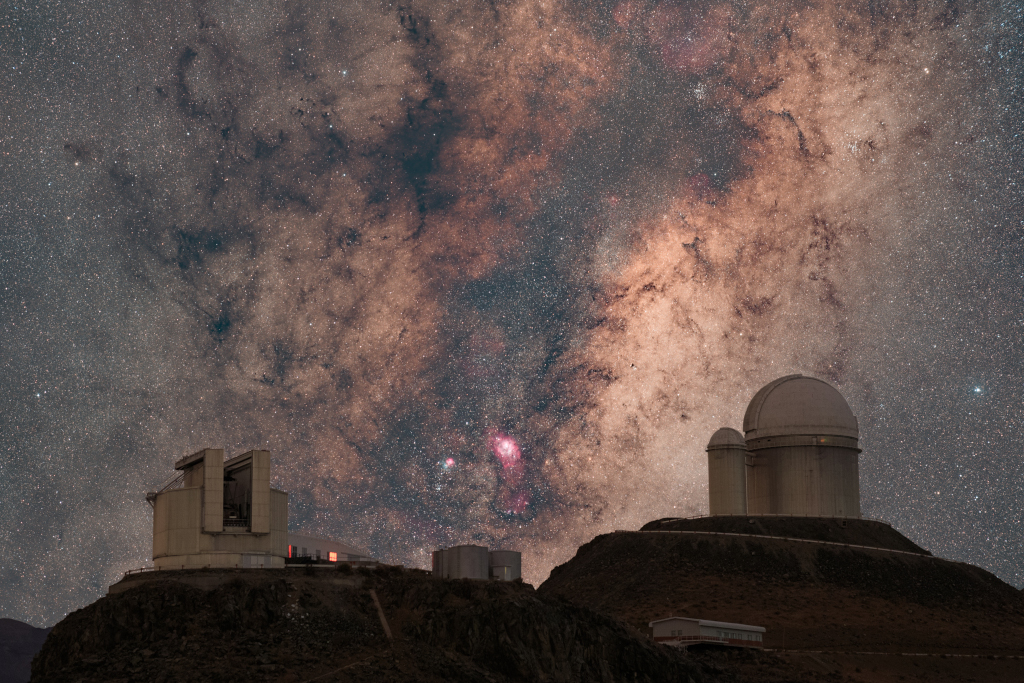
Nombre total de pages vues
31/12/2023
ASTRONOMIE - Photo - La lune dans les ailes

BIOMIMETISME - Innovations inspirées par la Nature - Des robots spatiaux équipés de patte de gecko

ASTRONOMY - Illustris: A Simulation of the Universe
2023 December 31
Video Credit: Illustris Collaboration, NASA, PRACE, XSEDE, MIT, Harvard CfA;
Music: The Poisoned Princess (Media Right Productions)
Explanation: How did we get here? Click play, sit back, and watch. A computer simulation of the evolution of the universe provides insight into how galaxies formed and perspectives into humanity's place in the universe. The Illustris project exhausted 20 million CPU hours in 2014 following 12 billion resolution elements spanning a cube 35 million light years on a side as it evolved over 13 billion years. The simulation tracks matter into the formation of a wide variety of galaxy types. As the virtual universe evolves, some of the matter expanding with the universe soon gravitationally condenses to form filaments, galaxies, and clusters of galaxies. The featured video takes the perspective of a virtual camera circling part of this changing universe, first showing the evolution of dark matter, then hydrogen gas coded by temperature (0:45), then heavy elements such as helium and carbon (1:30), and then back to dark matter (2:07). On the lower left the time since the Big Bang is listed, while on the lower right the type of matter being shown is listed. Explosions (0:50) depict galaxy-center supermassive black holes expelling bubbles of hot gas. Interesting discrepancies between Illustris and the real universe have been studied, including why the simulation produced an overabundance of old stars.
30/12/2023
ASTRONOMY - The Last Full Moon
2023 December 30
Image Credit & Copyright: Giacomo Venturin
Explanation: Known to some in the northern hemisphere as December's Cold Moon or the Long Night Moon, the last full moon of 2023 is rising in this surreal mountain and skyscape. The Daliesque scene was captured in a single exposure with a camera and long telephoto lens near Monte Grappa, Italy. The full moon is not melting, though. Its stretched and distorted appearance near the horizon is caused as refraction along the line of sight changes and creates shifting images or mirages of the bright lunar disk. The changes in atmospheric refraction correspond to atmospheric layers with sharply different temperatures and densities. Other effects of atmospheric refraction produced by the long sight-line to this full moon rising include the thin red rim seen faintly on the distorted lower edge of the Moon and a thin green rim along the top.
29/12/2023
ASTRONOMY - The Same Color Illusion
2023 December 18
Image Credit: Edward H. Adelson, Wikipedia
Explanation: Are squares A and B the same color? They are! To verify this, either run your cursor over the image or click here to see them connected. The featured illusion, an example of the same color illusion, illustrates that purely human perceptions in science may be ambiguous or inaccurate, even such a seemingly direct perception as relative color. Similar illusions exist on the sky, such as the size of the Moon near the horizon, or the apparent shapes of astronomical objects. The advent of automated, reproducible measuring devices such as CCDs have made science in general and astronomy in particular less prone to, but not free of, human-biased illusions.
BIOMIMETISME - Innovations inspirées par la Nature - Le bombyx du mûrier

28/12/2023
ASTRONOMY - Jupiter and the Geminid
2023 December 28
Image Credit & Copyright: Gaurav Singh
Explanation: For a brief moment, this brilliant fireball meteor outshone Jupiter in planet Earth's night. The serendipitous image was captured while hunting meteors under cold Canadian skies with a camera in timelapse mode on December 14, near the peak of the Geminid meteor shower. The Geminid meteor shower, asteroid 3200 Phaethon's annual gift, always arrives in December. Dust shed along the orbit of the mysterious asteroid causes the meteor streaks, as the vaporizing grains plow through our fair planet's upper atmosphere at 22 kilometers per second. Of course Geminid shower meteors appear to radiate from a point in the constellation of the Twins. That's below and left of this frame. With bright Jupiter on the right, also in the December night skyview are the Pleiades and Hyades star clusters.
27/12/2023
BIOMIMETISME - Innovations inspirées par la Nature - Ecrans inspirés des ailes transparentes d'un petit papillon

ASTRONOMY - Rainbow Aurora over Icelandic Waterfall
Image Credit & Copyright: Stefano Pellegrini
Explanation: Yes, but can your aurora do this? First, yes, auroras can look like rainbows even though they are completely different phenomena. Auroras are caused by Sun-created particles being channeled into Earth's atmosphere by Earth's magnetic field, and create colors by exciting atoms at different heights. Conversely, rainbows are created by sunlight backscattering off falling raindrops, and different colors are refracted by slightly different angles. Unfortunately, auroras can’t create waterfalls, but if you plan well and are lucky enough, you can photograph them together. The featured picture is composed of several images taken on the same night last month near the Skógafoss waterfall in Iceland. The planning centered on capturing the central band of our Milky Way galaxy over the picturesque cascade. By luck, a spectacular aurora soon appeared just below the curving arch of the Milky Way. Far in the background, the Pleiades star cluster and the Andromeda galaxy can be found.
26/12/2023
ASTRONOMY - IC 443: The Jellyfish Nebula
2023 December 26
Image Credit & Copyright: David Payne
Explanation: Why is this jellyfish swimming in a sea of stars? Drifting near bright star Eta Geminorum, seen at the right, the Jellyfish Nebula extends its tentacles from the bright arcing ridge of emission left of center. In fact, the cosmic jellyfish is part of bubble-shaped supernova remnant IC 443, the expanding debris cloud from a massive star that exploded. Light from the explosion first reached planet Earth over 30,000 years ago. Like its cousin in astronomical waters, the Crab Nebula supernova remnant IC 443 is known to harbor a neutron star -- the remnant of the collapsed stellar core. The Jellyfish Nebula is about 5,000 light-years away. At that distance, the featured image would span about 140 light-years across.
25/12/2023
BIOMIMETISME - Innovations inspirées par la Nature - Les feuilles autonettoyantes du lotus

ASTRONOMY - Cathedral - Mountain - Moon
2023 December 25
Image Credit & Copyright: Valerio Minato
Explanation: Single shots like this require planning. The first step is to realize that such an amazing triple-alignment actually takes place. The second step is to find the best location to photograph it. But it was the third step: being there at exactly the right time -- and when the sky was clear -- that was the hardest. Five times over six years the photographer tried and found bad weather. Finally, just ten days ago, the weather was perfect, and a photographic dream was realized. Taken in Piemonte, Italy, the cathedral in the foreground is the Basilica of Superga, the mountain in the middle is Monviso, and, well, you know which moon is in the background. Here, even though the setting Moon was captured in a crescent phase, the exposure was long enough for doubly reflected Earthlight, called the da Vinci glow, to illuminate the entire top of the Moon.
24/12/2023
ASTRONOMY - NGC 2440: Cocoon of a New White Dwarf
2023 December 24
Image Credit: NASA, ESA, Hubble; Processing: H. Bond (STScI), R. Ciardullo (PSU), Forrest Hamilton (STScI)
Explanation: What's that in the center? Like a butterfly, a white dwarf star begins its life by casting off a cocoon of gas that enclosed its former self. In this analogy, however, the Sun would be a caterpillar and the ejected shell of gas would become the prettiest cocoon of all. In the featured cocoon, the planetary nebula designated NGC 2440 contains one of the hottest white dwarf stars known. The white dwarf can be seen as the bright orange dot near the image center. Our Sun will eventually become a white dwarf butterfly, but not for another 5 billion years.
23/12/2023
ASTRONOMY - A December Summer Night
2023 December 23
Image Credit & Copyright: Ian Griffin (Otago Museum)
Explanation: Colours of a serene evening sky are captured in this 8 minute exposure, made near this December's solstice from New Zealand, southern hemisphere, planet Earth. Looking south, star trails form the short concentric arcs around the rotating planet's south celestial pole positioned just off the top of the frame. At top and left of center are trails of the Southern Cross stars and a dark smudge from the Milky Way's Coalsack Nebula. Alpha and Beta Centauri make the brighter yellow and blue tinted trails, reflected below in the waters of Hoopers Inlet in the Pacific coast of the South Island's Otago Peninsula. On that short December summer night, aurora australis also gave luminous, green and reddish hues to the sky above the hills. An upper atmospheric glow distinct from the aurora excited by collisions with energetic particles, pale greenish bands of airglow caused by a cascade of chemical reactions excited by sunlight can be traced in diagonal bands near the top left.
22/12/2023
ASTRONOMY - 183 Days in the Sun
2023 December 22
Image Credit & Copyright: José Zarcos Palma
Explanation: A single 183 day exposure with a pinhole camera and photographic paper resulted in this long-duration solargraph. Recorded from solstice to solstice, June 21 to December 21, in 2022, it follows the Sun's daily arcing path through planet Earth's skies from Mertola, Portugal. On June 21, the Sun's highest point and longest arc represents the longest day and the astronomical beginning of summer in the northern hemisphere. The solstice date with the fewest hours of daylight is at the beginning of winter in the north, corresponding to the Sun's shortest and lowest arc in the 2022 solargraph. For 2023, the northern winter solstice was on December 22 at 3:27 UTC. That's December 21 for North America time zones.
17/12/2023
ASTRONOMY - Geminids over China's Nianhu Lake
2023 December 17
Image Credit & Copyright: Hongyang Luo
Explanation: Where are all of these meteors coming from? In terms of direction on the sky, the pointed answer is the constellation of Gemini. That is why the major meteor shower in December is known as the Geminids -- because shower meteors all appear to come from a radiant toward Gemini. Three dimensionally, however, sand-sized debris expelled from the unusual asteroid 3200 Phaethon follows a well-defined orbit about our Sun, and the part of the orbit that approaches Earth is superposed in front of the constellation of Gemini. Therefore, when Earth crosses this orbit, the radiant point of falling debris appears in Gemini. Featured here is a composite of many images taken a few days ago through dark skies from Nianhu Lake in China. Over 100 bright meteor streaks from the Geminids meteor shower are visible.
AERONAUTIQUE - Les plus gros avions du monde - Antonov An-124 (Condor)

16/12/2023
LA FRANCE A L'AFFICHE - Place du Capitole - Toulouse
ASTRONOMY - Crescent Enceladus
2023 December 16
Image Credit: Cassini Imaging Team, SSI, JPL, ESA, NASA
Explanation: Peering from the shadows, the Saturn-facing hemisphere of tantalizing inner moon Enceladus poses in this Cassini spacecraft image. North is up in the dramatic scene captured during November 2016 as Cassini's camera was pointed in a nearly sunward direction about 130,000 kilometers from the moon's bright crescent. In fact, the distant world reflects over 90 percent of the sunlight it receives, giving its surface about the same reflectivity as fresh snow. A mere 500 kilometers in diameter, Enceladus is a surprisingly active moon. Data and images collected during Cassini's flybys have revealed water vapor and ice grains spewing from south polar geysers and evidence of an ocean of liquid water hidden beneath the moon's icy crust.
15/12/2023
AERONAUTIQUE - Les plus gros avions du monde - Tupolev Tu-160 (Cygne blanc)

ASTRONOMY - Betelgeuse Eclipsed
2023 December 15
Image Credit & Copyright: Sebastian Voltmer
Explanation: Asteroid 319 Leona cast a shadow across planet Earth on December 12, as it passed in front of bright star Betelgeuse. But to see everyone's favorite red giant star fade this time, you had to stand near the center of the narrow shadow path starting in central Mexico and extending eastward across southern Florida, the Atlantic Ocean, southern Europe, and Eurasia. The geocentric celestial event is captured in these two panels taken at Almodovar del Rio, Spain from before (left) and during the asteroid-star occultation. In both panels Betelgeuse is seen above and left, at the shoulder of the familiar constellation Orion. Its brightness diminishes noticeably during the exceedingly rare occultation when, for several seconds, the giant star was briefly eclipsed by a roughly 60 kilometer diameter main-belt asteroid.
14/12/2023
ASTRONOMY - Supernova Remnant Cassiopeia A
2023 December 14
Image Credit: NASA, ESA, CSA, STScI; D. Milisavljevic (Purdue University), T. Temim (Princeton University), I. De Looze (University of Gent)
Explanation: Massive stars in our Milky Way Galaxy live spectacular lives. Collapsing from vast cosmic clouds, their nuclear furnaces ignite and create heavy elements in their cores. After only a few million years for the most massive stars, the enriched material is blasted back into interstellar space where star formation can begin anew. The expanding debris cloud known as Cassiopeia A is an example of this final phase of the stellar life cycle. Light from the supernova explosion that created this remnant would have been first seen in planet Earth's sky about 350 years ago, although it took that light 11,000 years to reach us. This sharp NIRCam image from the James Webb Space Telescope shows the still hot filaments and knots in the supernova remnant. The whitish, smoke-like outer shell of the expanding blast wave is about 20 light-years across, while the bright speck near center is a neutron star, the incredibly dense, collapsed remains of the massive stellar core. Light echoes from the massive star's cataclysmic explosion are also identified in Webb's detailed image of supernova remnant Cassiopeia A.
13/12/2023
AERONAUTIQUE - Les plus gros avions du monde - Hughes H-4 Hercules (Spruce Goose)

12/12/2023
ASTRONOMY - Aurora and Milky Way over Norway
2023 December 12
Image Credit & Copyright: Giulio Cobianchi
Explanation: What are these two giant arches across the sky? Perhaps the more familiar one, on the left, is the central band of our Milky Way Galaxy. This grand disk of stars and nebulas here appears to encircle much of the southern sky. Visible below the stellar arch is the rusty-orange planet Mars and the extended Andromeda galaxy. But this night had more! For a few minutes during this cold arctic night, a second giant arch appeared encircling part of the northern sky: an aurora. Auroras are much closer than stars as they are composed of glowing air high in Earth's atmosphere. Visible outside the green auroral arch is the group of stars popularly known as the Big Dipper. The featured digital composite of 20 images was captured in mid-November 2022 over the Lofoten Islands in Norway.
11/12/2023
ASTRONOMY - Solar Minimum versus Solar Maximum
2023 December 11
Video Credit: NASA, SDO, SVS
Explanation: The surface of our Sun is constantly changing. Some years it is quiet, showing relatively few sunspots and active regions. Other years it is churning, showing many sunspots and throwing frequent Coronal Mass Ejections (CMEs) and flares. Reacting to magnetism, our Sun's surface goes through periods of relative calm, called Solar Minimum and relative unrest, called Solar Maximum, every 11 years. The featured video shows on the left a month in late 2019 when the Sun was near Solar Minimum, while on the right a month in 2014 when near Solar Maximum. The video was taken by NASA's Solar Dynamic Observatory in far ultraviolet light. Our Sun is progressing again toward Solar Maximum in 2025, but displaying even now a surface with a surprisingly high amount of activity.
10/12/2023
ASTRONOMY - Big Dipper over Pyramid Mountain
2023 December 10
Image Credit & Copyright: Steve Cullen
Explanation: When did you first learn to identify this group of stars? Although they are familiar to many people around the world, different cultures have associated this asterism with different icons and folklore. Known in the USA as the Big Dipper, the stars are part of a constellation designated by the International Astronomical Union in 1922 as the Great Bear (Ursa Major). The recognized star names of these stars are (left to right) Alkaid, Mizar/Alcor, Alioth, Megrez, Phecda, Merak, and Dubhe. Of course, stars in any given constellation are unlikely to be physically related. But surprisingly, most of the Big Dipper stars do seem to be headed in the same direction as they plough through space, a property they share with other stars spread out over an even larger area across the sky. Their measured common motion suggests that they all belong to a loose, nearby star cluster, thought to be on average only about 75 light-years away and up to 30 light-years across. The cluster is more properly known as the Ursa Major Moving Group. The featured image captured the iconic stars recently above Pyramid Mountain in Alberta, Canada.
09/12/2023
AERONAUTIQUE - Les plus gros avions du monde - Stratolaunch

ASTRONOMY - Pic du Pleiades
2023 December 9
Image Credit & Copyright: Jean-Francois Graffand
Explanation: Near dawn on November 19 the Pleiades stood in still dark skies over the French Pyrenees. But just before sunrise a serendipitous moment was captured in this single 3 second exposure; a bright meteor streak appeared to pierce the heart of the galactic star cluster. From the camera's perspective, star cluster and meteor were poised directly above the mountain top observatory on the Pic du Midi de Bigorre. And though astronomers might consider the Pleiades to be relatively close by, the grain of dust vaporizing as it plowed through planet Earth's upper atmosphere actually missed the cluster's tight grouping of young stars by about 400 light-years. While recording a night sky timelapse series, the camera and telephoto lens were fixed to a tripod on the Tour-de-France-cycled slopes of the Col du Tourmalet about 5 kilometers from the Pic du Midi.
08/12/2023
ASTRONOMY - Vega and Comet 12P/Pons-Brooks
2023 December 8
Image Credit & Copyright: Dan Bartlett
Explanation: On December 4, periodic Comet 12P/Pons-Brooks shared this telescopic field of view with Vega, alpha star of the northern constellation Lyra. Fifth brightest star in planet Earth's night, Vega is some 25 light-years distant while the much fainter comet was about 21 light-minutes away. In recent months, outbursts have caused dramatic increases in brightness for Pons-Brooks though. Nicknamed the Devil Comet for its hornlike appearance, fans of interstellar spaceflight have also suggested the distorted shape of this comet's large coma looks like the Millenium Falcon. A Halley-type comet, 12P/Pons-Brooks last visited the inner Solar System in 1954. Its next perihelion passage or closest approach to the Sun will be April 21, 2024. That's just two weeks after the April 8 total solar eclipse path crosses North America. But, highly inclined to the Solar System's ecliptic plane, the orbit of periodic Comet 12P/Pons-Brooks will never cross the orbit of planet Earth.
07/12/2023
SANTé/MEDECINE - L'Histoire en images - L'Égypte antique et la momification

BIOMIMETISME - Innovations inspirées par la Nature - Le Shinkansen, le train au bec d'oiseau

GEMMOLOGIE - Joaillerie Céleste (Et spaciale) - La conquête de l’espace (A partir des années 1950)


ASTRONOMY - Orion and the Ocean of Storms
023 December 7
Image Credit: NASA, Artemis 1
Explanation: On December 5, 2022, a camera on board the uncrewed Orion spacecraft captured this view as Orion approached its return powered flyby of the Moon. Beyond one of Orion's extended solar arrays lies dark, smooth, terrain along the western edge of the Oceanus Procellarum. Prominent on the lunar nearside Oceanus Procellarum, the Ocean of Storms, is the largest of the Moon's lava-flooded maria. The lunar terminator, shadow line between lunar night and day, runs along the left of this frame. The 41 kilometer diameter crater Marius is top center, with ray crater Kepler peeking in at the edge, just right of the solar array wing. Kepler's bright rays extend to the north and west, reaching the dark-floored Marius. On December 11, 2022 the Orion spacecraft reached its home world. The historic Artemis 1 mission ended with Orion's successful splashdown in planet Earth's water-flooded Pacific Ocean.
06/12/2023
ASTRONOMY - Stars Versus Dust in the Carina Nebula
2023 December 6
Image Credit: NASA, ESA, Hubble Heritage (STScI/AURA); Processing: Franco Meconi (Terraza al Cosmos)
Explanation: It's stars versus dust in the Carina Nebula and the stars are winning. More precisely, the energetic light and winds from massive newly formed stars are evaporating and dispersing the dusty stellar nurseries in which they formed. Located in the Carina Nebula and inside a region known informally as Mystic Mountain, these pillars' appearance is dominated by opaque brown dust even though it is composed mostly of clear hydrogen gas. Even though some of the dust pillars look like torches, their ends are not on fire -- rather, they are illuminated by nearby stars. About 7,500 light-years distant, the featured image was taken with the Hubble Space Telescope and highlights an interior region of Carina known as HH1066 which spans nearly a light year. Within a few million years, the stars will likely win out completely and the dust torches will completely evaporate.
05/12/2023
GEMMOLOGIE - Joaillerie Céleste (Et spaciale) - Les croissants de lune (Époque Victorienne et après)

ASTRONOMY - Energetic Particle Strikes the Earth
2023 December 5
Illustration Credit: Osaka Metropolitan U./L-INSIGHT, Kyoto U./Ryuunosuke Takeshige
Explanation: It was one of the most energetic particles ever known to strike the Earth -- but where did it come from? Dubbed Amaterasu after the Shinto sun goddess, this particle, as do all cosmic rays that strike the Earth's atmosphere, caused an air shower of electrons, protons, and other elementary particles to spray down onto the Earth below. In the featured illustration, a cosmic ray air shower is pictured striking the Telescope Array in Utah, USA, which recorded the Amaterasu event in 2021 May. Cosmic ray air showers are common enough that you likely have been in a particle spray yourself, although you likely wouldn't have noticed. The origin of this energetic particle, likely the nucleus of an atom, remains a mystery in two ways. First, it is not known how any single particle or atomic nucleus can practically acquire so much energy, and second, attempts to trace the particle back to where it originated did not indicate any likely potential source.
04/12/2023
ASTRONOMY - Plane Crossing Crescent Moon
2023 December 4
Image Credit & Copyright: Juned Patel
Explanation: No, the Moon is not a bow, and no, it did not shoot out a plane like an arrow. What is pictured is a chance superposition. The plane's contrail would normally appear white, but the large volume of air toward the rising Sun preferentially knocked away blue light, not only making the sky blue, but giving the reflected trail a bright red hue. Far in the distance, well behind the plane, the crescent Moon also appears slightly reddened. Captured early last month from Bolton, UK, the featured image was taken so soon after sunrise that the plane was sunlit from below, as was its contrail. Within minutes, unfortunately, the impromptu sky show ended. The plane moved out of sight. The Moon kept rising but became harder to see through a brightening sky. And the contrail gradually dispersed.
03/12/2023
ASTRONOMY - Moon Setting Behind Teide Volcano
2023 December 3
Video Credit & Copyright: Daniel López (El Cielo de Canarias); Music: Piano della Moon (Dan Silva)
Explanation: These people are not in danger. What is coming down from the left is just the Moon, far in the distance. Luna appears so large here because she is being photographed through a telescopic lens. What is moving is mostly the Earth, whose spin causes the Moon to slowly disappear behind Mount Teide, a volcano in the Canary Islands off the northwest coast of Africa. The people pictured are 16 kilometers away and many are facing the camera because they are watching the Sun rise behind the photographer. It is not a coincidence that a full moon rises just when the Sun sets because the Sun is always on the opposite side of the sky from a full moon. The featured video was made in 2018 during the full Milk Moon. The video is not time-lapse -- this was really how fast the Moon was setting.
02/12/2023
ASTRONOMY - Startrails over Beijing Ancient Observatory
Image Credit & Copyright: Jeff Dai (TWAN)
Explanation: You can take a subway ride to visit this observatory in Beijing, China but you won't find any telescopes there. Starting in the 1400s astronomers erected devices at the Beijing Ancient Observatory site to enable them to accurately measure and track the positions of naked-eye stars and planets. Some of the large, ornate astronomical instruments are still standing. You can even see stars from the star observation platform today, but now only the very brightest celestial beacons are visible against the city lights. In this time series of exposures from a camera fixed to a tripod to record graceful arcing startrails, the brightest trail is actually the Moon. Its broad arc is seen behind the ancient observatory's brass armillary sphere. Compare this picture from the Beijing Ancient Observatory taken in September 2023 to one taken in 1895.
01/12/2023
GEMMOLOGIE - Joaillerie Céleste (Et spaciale) - Les bijoux dédiés à l’étoile polaire (Époque Victorienne et après)
AERONAUTIQUE - Les plus gros avions du monde - Antonov AN-225 Mriya

ASTRONOMY - Milky Way Rising
2023 December 1
Image Credit & Copyright: José Rodrigues
Explanation: The core of the Milky Way is rising beyond the Chilean mountain-top La Silla Observatory in this deep night skyscape. Seen toward the constellation Sagittarius, our home galaxy's center is flanked on the left, by the European Southern Observatory's New Technology Telescope which pioneered the use of active optics to accurately control the shape of large telescope mirrors. To the right stands the ESO 3.6-meter Telescope, home of the exoplanet hunting HARPS and NIRPS spectrographs. Between them, the galaxy's central bulge is filled with obscuring clouds of interstellar dust, bright stars, clusters, and nebulae. Prominent reddish hydrogen emission from the star-forming Lagoon Nebula, M8, is near center. The Trifid Nebula, M20, combines blue light of a dusty reflection nebula with reddish emission just left of the cosmic Lagoon. Both are popular stops on telescopic tours of the galactic center. The composited image is a stack of separate exposures for ground and sky made in April 2023, all captured consecutively with the same framing and camera equipment.
ASTRONOMY - Visualization: Near a Black Hole and Disk
2025 December 3 Visualization: Near a Black Hole and Disk Illustration Credit: NASA 's GSFC , J. Schnittman & B. Powell ; Text...

-
2022 September 26 All the Water on Planet Earth Illustration Credit: Jack Cook, Adam Nieman, Woods Hole Oceanographic Institution ; Data ...
-
2025 May 11 The Surface of Venus from Venera 14 Image Credit: Soviet Planetary Exploration Program , Venera 14 ; Processing & Copyri...
